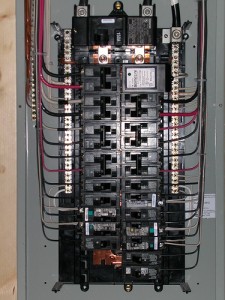Don’t Blow a Fuse Over a Tripped Breaker!
 If you have ever had a problem in your Chicagoland home with a tripped breaker or a blown fuse that just left you confused on what to do next, don’t fret. The answer may be as simple as an overloaded circuit or a bad cord. Although you may feel resetting a breaker or replacing a fuse is cumbersome work, the fact is these over-current devices are in place for your safety. However, if you are the least bit uncomfortable, don’t hesitate to call your Chicagoland electrician – electrical issues are not worth compromising your safety for.
If you have ever had a problem in your Chicagoland home with a tripped breaker or a blown fuse that just left you confused on what to do next, don’t fret. The answer may be as simple as an overloaded circuit or a bad cord. Although you may feel resetting a breaker or replacing a fuse is cumbersome work, the fact is these over-current devices are in place for your safety. However, if you are the least bit uncomfortable, don’t hesitate to call your Chicagoland electrician – electrical issues are not worth compromising your safety for.
Protect The Wiring
Without over-current devices, your Chicagoland home’s electrical wiring could overload and heat up. At some point, this can actually cause a fire. If you have a tripped breaker or blown fuse, you can bet there is a problem in one of the electrical circuits. The following simple steps can help you find the problem and keep your family safe.
Lights Out
Oh no, the power went out, but why? The first step to finding that answer is to head to your electrical panel that will be equipped with either breakers or fuses. On the face of the box will be a door. You need to open the door and look at the position of the breakers. Are they all in the “on” position? That would be the switch part of the breaker that should be pushed towards the center of the box. If a breaker is not fully towards the center and has flipped back towards the outer side of the panel, you have likely found the culprit. Now if you have fuses and a fuse has blown, the clear hole in the middle will likely be a dark, burnt color. This fuse can be checked with an ohm meter or continuity light to see if it is good or not.
Identify The Circuit
Regardless of which type of panel you have, the next step is to look over the panel schedule on the inside of the door. Hopefully, the electrician that wired your Chicagoland home has placed the location or device (dishwasher, kitchen outlet, etc.) that each circuit feeds on the panel schedule for your convenience. The way the panels are set up, when counting down the left side the numbers are 1, 3, 5, etc. Likewise, the numbers on the right side are 2, 4, 6, etc. Now, count down to the breaker that has tripped. Using that number breaker on the panel schedule, look to see what the circuit is feeding. With fuses, they are generally listed 1, 2, 3, 4, etc. from left to right.
Inspect The Area
Okay, let’s say your circuit is feeding a kitchen countertop outlet. You go to the kitchen and inspect to see if there is anything obvious that may have caused an overload, a ground fault, or a short. Confused? Let me explain.
Don’t Overload
An overloaded circuit simply means that there is more power being used than is available via the breaker or fuse. A 20 amp breaker only allows up to 20 amps to flow through it before it trips. Likewise, a 20 amp fuse will only allow 20 amps to flow through it before it blows. It has been my experience that a fuse will generally blow easier than a breaker will trip when the maximum is reached. However, a fuse can only blow once while a breaker can be reset.
Ground Faults
A ground fault occurs when the flow of current is not balanced between the hot wire and neutral wire. A specially designed outlet called a GFI (ground fault interrupter) is used that detects this and disconnects a circuit. A GFI is used where water is within five feet of the outlet. This outlet has a test button and a reset button built into it.
Instead of a GFI outlet, you may have a GFI breaker. When there is a problem, say a mixer falls into your sink water, the GFI opens the circuit and cuts off electricity to the mixer. Likewise, it will trip if you have a hand in the water while touching an appliance that may have a frayed wire. The built-in safety feature could save you or your family’s life.
Shorted
A short is caused when the hot wire and either the neutral or ground wire make contact. In a typical panel, the black wire is the hot wire, the white wire is the neutral and the green or bare copper wire is the ground. Shorting of a circuit could be caused by someone driving a nail or screw into a wall and through the wire supplying the outlet.
Some people have problems with an occasional mouse in the house. These critters love to chew on everything and sometimes they chew right through the wire’s insulation and short out a circuit. An appliance, say a vacuum, may have a motor lock up and its motor windings may short together causing the problem.
Problems and More Problems
A few other causes may include a frayed cord on a countertop appliance, too many appliances plugged into the same outlet, loose wires on the outlet itself, or something shorted out. Try unplugging all of the devices that are being fed on that particular circuit. This may include more than one outlet on your countertop.
Check the outlet with a voltmeter to see if indeed the circuit is off. Now, try resetting the breaker. If the circuit trips again, you may have a serious wiring problem. But if it stays on and clears, you know it is not in your wiring. In this case, turn the circuit back off and try plugging one device at a time into the outlet. Turn the circuit on again and repeat until you find the problem device or cord. In the case of fuses, you may have to sacrifice a few fuses for the good of the investigation.
Digging Deeper
As you can see, many things can cause the problem. The key is finding which thing. A good rule of thumb is not to be scared of electricity, just respect it!
If you are not comfortable digging any deeper into a circuit problem, then you should call your Chicagoland electrician to the rescue. A simple short circuit today can lead to costly repairs later. Don’t put off either finding the problem yourself or calling a professional.
Article Source: http://electrical.about.com/od/panelsdistribution/a/breakerbreaker.htm






